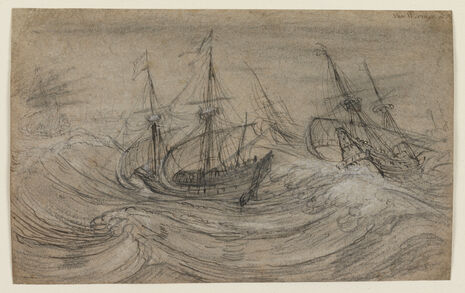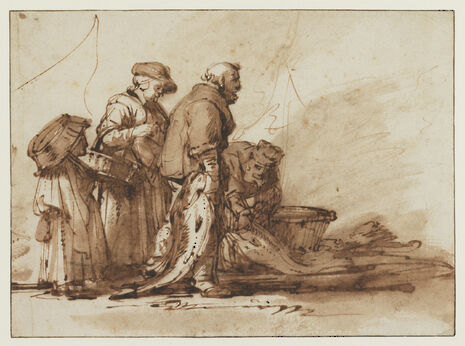Review: Making Waves at the Fitzwilliam Museum
Emma Slater reviews a new exhibition of seascapes in watercolour and drawings

The Fitzwilliam Museum’s new exhibition Making Waves is a single room. Located in the Shiba gallery on the first floor, it is easy to miss and doesn’t claim the most exhilarating of subjects: ‘Discovering seascapes through drawings and watercolours.’ Nonetheless, the exhibition is an intimate look at seascapes and depictions of maritime exploration from the 16th century – a subject just emerging at the time, and one that would become integral to the Dutch Golden Age.
“if you’re not an avid fan of watercolours it might be safe to say that you won’t enjoy this exhibition”
The majority of the works in this exhibition are no bigger than a sheet of A4 paper. Many of them have the appearance of a preliminary sketch for a more substantial work, and some, such as a “panoramic view of the English fleet off the Dutch coast at Scheveningen,” 1660, and Willem van de Velde the Elder’s ‘Mary of Madena embanking Gravesend,’ 1673, consist of multiple sheets of paper meshed together to form a semi-composite piece. The unfinished feel of these watercolours and drawings give not only an unusual perspective on seascapes, warships, and maritime endeavours, but also an intimate glimpse into the artists’ processes in depicting them.

If you’re not an avid fan of watercolours, it might be safe to say that you won’t enjoy this exhibition: in places, it does feel that the room is awash with grey. However, there are some uncharacteristic pieces such as Conelis Claesz van Wieringen’s dramatic charcoal drawing ‘Shipping in a rough sea,’ depicting huge, dark waves consuming a ship as if it were its prey. This drawing is given as an example of the political agenda of seascapes in the 17th century, depictions of shipwrecks often representing the symbolic ‘Ship of State’. The political symbolism of seascapes is an interesting aspect which should perhaps have been further engaged with throughout the exhibition. For instance, there were some uninteresting watercolours by Jan Peeters such as ‘A view of Alexandria in Egypt’ and ‘View of Zaffia in Barbary,’ both c.1665, which must have captivated 17th century audiences with their depictions of foreign, ‘exotic’ lands, but now simply feel pale and bland. More information could have related these watercolours to a broader historical context of Dutch imperialism.
“the political symbolism of seascapes is an interesting aspect which should perhaps have been further engaged with”
The highlight of the exhibition, however, were two drawings of the huge war-ship ‘De Eendracht’ by Willem van de Velde the Elder, both 1665. At contrast to the grey, often pallid, washes of the rest of the exhibition, these line drawings are of a larger scale and have a confidence and drama that isn’t present in the calm sailing ships of Everhardus Koster’s pre-1859 watercolour ‘A beach scene in Scheveningen’ immediately to their left. The accompanying description labels the drawings ‘ship portraits,’ which is wholly accurate: the boats are portrayed with such character and personality – almost to the point of caricature – that they seem just like people.

Real people, however, are almost completely missing from this exhibition. Simon de Vlieger’s ink drawing, ‘A group of fisherfolk’, c.1640s, is displayed on the front table and is a captivating sketch of fishermen holding their catches on the shore. The piece is reminiscent of Rembrandt’s drawings and for a while it was even attributed to a pupil of his. Other than this, however, the only representations of humanity in these drawings and watercolours are the pale, miniscule figures on the decks of the ships, or the lonely silhouettes on the shore. In these works, people are pushed to the side-lines in favour of maritime displays of wealth and power – ironic considering that, as Pieter de la Court estimated, 450,000 people at this time were employed in the fishing industry compared to just 200,000 in agriculture.
Indeed, although the exhibition displays many unusual, rarely seen watercolours and drawings of seascapes and ships, it seems to me that the best parts of Making Waves are rough sketches of people, or drawings of ships that look like people.
‘Making Waves: Discovering seascapes through drawings and watercolours’ is at the Fitzwilliam Museum, Tuesday 14 February 2017 to Sunday 21 May 2017
 News / Police to stop searching for stolen Fitzwilliam jade17 April 2024
News / Police to stop searching for stolen Fitzwilliam jade17 April 2024 News / Copycat don caught again19 April 2024
News / Copycat don caught again19 April 2024 Interviews / ‘It fills you with a sense of awe’: the year abroad experience17 April 2024
Interviews / ‘It fills you with a sense of awe’: the year abroad experience17 April 2024 News / Night Climbers call for Cambridge to cut ties with Israel in new stunt15 April 2024
News / Night Climbers call for Cambridge to cut ties with Israel in new stunt15 April 2024 News / Acting vice-chancellor paid £234,000 for nine month stint19 April 2024
News / Acting vice-chancellor paid £234,000 for nine month stint19 April 2024




